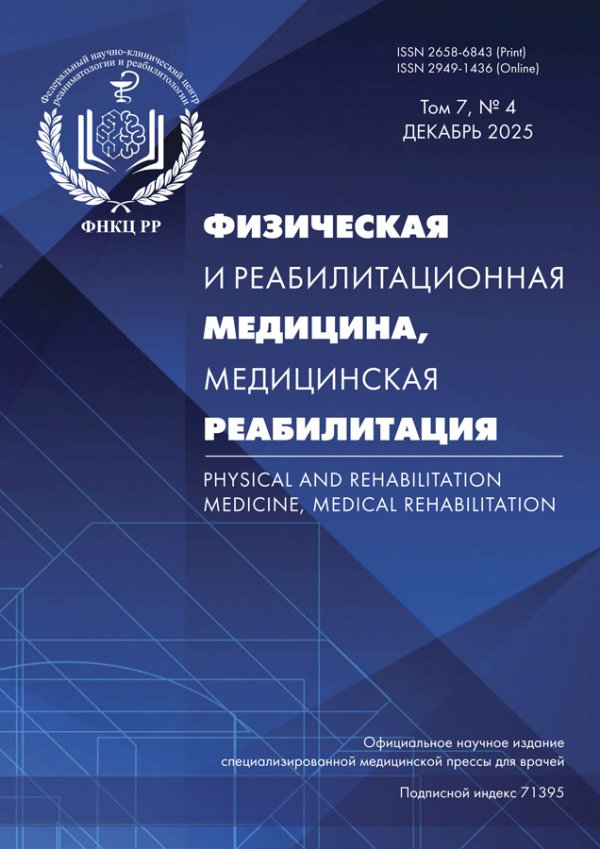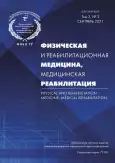Diagnostic of psychoemotional and cognitive impairments in acute ischemic stroke
- Authors: Tynterova A.M.1, Perepelitsa S.A.1,2, Skalin Y.E.1, Reverchuk I.V.1, Yakovlev M.Y.3,4, Tikhonova O.A.1, Grishina A.A.1
-
Affiliations:
- Imannuel Kant Baltic Federal University
- Federal Research and Clinical Center of Intensive Care Medicine and Rehabilitology
- National Medical Research Center for Rehabilitation and Balneology of the Ministry of Health of the Russian Federation
- Center for Strategic Planning and Management of Biomedical Health Risks of the Federal Medical and Biological Agency of Russia
- Issue: Vol 3, No 3 (2021)
- Pages: 270-280
- Section: ORIGINAL STUDY ARTICLE
- URL: https://journals.rcsi.science/2658-6843/article/view/77964
- DOI: https://doi.org/10.36425/rehab77964
- ID: 77964
Cite item
Full Text
Abstract
Background. Early rehabilitation of patients with stroke is an important aspect of modern healthcare. The leading factor in disability is polymorphism of movement disorders, which is associated with dysfunction of various parts of the movement regulation system. Disorders of higher mental functions are another group of functional disorders widely represented among stroke patient.
Aims: To assess the severity of cognitive, psychoemotional, behavioral disorders, the level of self-control and prevalence of certain coping strategies in patients with lesions of the right and left cerebral hemispheres after acute ischemic stroke.
Material and methods. The study included 60 patients with a diagnosis of ischemic stroke. Depending on the location of the stroke, patients were divided into two groups: Group 1 — 30 patients with lesions of the right hemisphere, Group 2 — 30 patients with lesions of the left hemisphere. The study was conducted on the 7th day of treatment and included: assessment of the cognitive status according to the Montreal scale (with additional scales for assessing the functions of the right hemisphere); assessment of the level of distress, depression, anxiety and somatization using the Four Dimensional Symptom Questionnaire; assessment of mental and physical asthenia according to the MFI-20 scale, level of self-control using the Rotter's Locus of Control Scale and coping strategies modality using E. Heim coping questionnaire.
Results. The study established the prevalence of depression, a tendency towards non-adaptive coping strategies, ideational praxis related disorders “understanding of metaphors” and low level of self-control in relation to health in patients with lesions of the right hemisphere. Patients with ischemic stroke localized in the left hemisphere are characterized by a high level of mental asthenia, a choice of adaptive and relatively adaptive coping strategies, and a low level of self-control in respect to interpersonal relationships.
Conclusions. The results of the study show that in the acute period of stroke there are qualitative and quantitative differences in neuropsychiatric symptoms of patients with lesions of the right and left cerebral hemispheres. The predominance of depression, cognitive impairments, and non-adaptive coping strategies in patients with lesions of the right hemisphere even with minimal or moderate motor deficits justifies early examination of the patient's behavioral, neuropsychiatric, and cognitive syndromes. The results of the study indicate the need to develop individual psychological rehabilitation programs for patients with lesions of the right and left cerebral hemispheres during the acute period of stroke.
Full Text
##article.viewOnOriginalSite##About the authors
Anastasiya M. Tynterova
Imannuel Kant Baltic Federal University
Author for correspondence.
Email: antynterova@mail.ru
ORCID iD: 0000-0003-1743-4713
SPIN-code: 2999-5812
MD, Cand. Sci. (Med.)
Russian Federation, 14 Alexander Nevsky Str., Kaliningrad, 236041Svetlana A. Perepelitsa
Imannuel Kant Baltic Federal University; Federal Research and Clinical Center of Intensive Care Medicine and Rehabilitology
Email: sveta_perepeliza@mail.ru
ORCID iD: 0000-0002-4535-9805
SPIN-code: 4428-8031
MD, Dr. Sci. (Med.), Professor, V.A. Negovsky Research Institute of General Reanimatology
Russian Federation, 14 Alexander Nevsky Str., Kaliningrad, 236041; MoscowYurii E. Skalin
Imannuel Kant Baltic Federal University
Email: iskalin@kantiana.ru
ORCID iD: 0000-0001-5504-0307
SPIN-code: 1983-3348
MD, Cand. Sci. (Psych.)
Russian Federation, 14 Alexander Nevsky Str., Kaliningrad, 236041Igor V. Reverchuk
Imannuel Kant Baltic Federal University
Email: igor7272igor@gmail.com
ORCID iD: 0000-0002-3498-9094
SPIN-code: 1506-1036
MD, Dr. Sci. (Med.), Professor
Russian Federation, 14 Alexander Nevsky Str., Kaliningrad, 236041Maxim Yu. Yakovlev
National Medical Research Center for Rehabilitation and Balneology of the Ministry of Health of the Russian Federation; Center for Strategic Planning and Management of Biomedical Health Risks of the Federal Medical and Biological Agency of Russia
Email: masdat@mail.ru
ORCID iD: 0000-0002-5260-8304
SPIN-code: 3832-3419
MD, Сand. Sci. (Med.), Assistant Professor
Russian Federation, Moscow; MoscowOlga A. Tikhonova
Imannuel Kant Baltic Federal University
Email: offelia78@mail.ru
ORCID iD: 0000-0002-1796-0193
Graduate Student
Russian Federation, 14 Alexander Nevsky Str., Kaliningrad, 236041Anastasiya A. Grishina
Imannuel Kant Baltic Federal University
Email: maybenastyaa@gmail.com
ORCID iD: 0000-0001-7571-4815
Russian Federation, 14 Alexander Nevsky Str., Kaliningrad, 236041
References
- ВОЗ публикует статистику о ведущих причинах смертности и инвалидности во всем мире за период 2000–2019 гг. [WHO publishes statistics on the leading causes of death and disability worldwide for the period 2000–2019. (In Russ).] Режим доступа: https://www.who.int/ru/news/item/09-12-2020-who-reveals-leading-causes-of-death-and-disability-worldwide-2000-2019. Дата обращения: 15.04.2021.
- ВОЗ. 10 ведущих причин смерти в мире. [The top 10 causes of death. (In Russ).] Режим доступа: https://www.who.int/ru/news-room/fact-sheets/detail/the-top-10-causes-of-death. Дата обращения: 15.04.2021.
- Пирадов М.А., Максимова М.Ю., Танашян М.М. Инсульт: пошаговая инструкция. Рук-во для врачей. 2-е изд., перераб. и дополн. Москва: ГЭОТАР- Медиа, 2020. 288 с. [Piradov MA, Maksimova MYu, Tanashyan MM. Stroke: step by step instructions. A guide for doctors. 2nd ed., revised and updated. Moscow: GEOTAR-Media; 2020. 288 p. (In Russ).]
- Клочихина О.А., Шпрах В.В., Стаховская Л.В., и др. Динамика показателей заболеваемости инсультом и смертности от него за восьмилетний период на территориях, вошедших в федеральную программу реорганизации помощи пациентам с инсультом // Acta Biomedica Scientifica. 2021. Т. 6, № 1. С. 75–80. [Klochikhina OA, Shprakh VV, Stakhovskaya LV, et al. Dynamics of stroke incidence and mortality indicators over eight-year period in the territories included into the federal program of reorganization of care for patients with stroke. Acta Biomedica Scientifica. 2021;6(1):75–80. (In Russ).] doi: 10.29413/ABS.2021-6.1.10
- Левин О.С. Постинсультные двигательные нарушения // Современная терапия в психиатрии и неврологии. 2016. № 3. С. 25–32. [Levin OS. Post-stroke motor disorders. Sovremennaya terapiya v psikhiatrii i nevrologii. 2016;(3):25–32. (In Russ).]
- Вербицкая С.В., Парфенов В.А., Решетников В.А., и др. Постинсультные когнитивные нарушения (результаты 5-летнего наблюдения) // Неврология, нейропсихиатрия, психосоматика. 2018. Т. 10, № 1. С. 37–42. [Verbitskaya SV, Parfenov VA, Reshetnikov VA, et al. Post-stroke cognitive impairment (results of a 5-year follow-up). Neurology, Neuropsychiatry, Psychosomatics. 2018;10(1):37–42. (In Russ).] doi: 10.14412/2074-2711-2018-1-37-42
- Голубев А.М., Петрова М.В., Гречко А.В., и др. Молекулярные маркеры ишемического инсульта // Общая реаниматология. 2019. Т. 15, № 5. С. 11–22. [Golubev AM, Petrova MV, Grechko AV, et al. Molecular markers of ischemic stroke. General Reanimatology. 2019;15(5): 11–22. (In Russ).] doi: 10.15360/1813-9779-2019-5-11-22
- Лурия А.Р. Высшие корковые функции человека. Санкт-Петербург: Питер, 2008. 624 с. [Luria AR. Higher cortical functions of a person. Saint-Petersburg: Piter; 2008. 624 р. (In Russ).]
- Bartolomeo P, Seidel Malkinson T. Hemispheric lateralization of attention processes in the human brain. Curr Opin Psychol. 2019;29:90–96. doi: 10.1016/j.copsyc.2018.12.023
- Chaumillon R, Blouin J, Guillaume A. Interhemispheric transfer time asymmetry of visual information depends on eye dominance: an electrophysiological study. Front Neurosci. 2018;12:72. doi: 10.3389/fnins.2018.00072
- Балашова Е.Ю. Временная перспектива нейропсихологической диагностики: путь к будущему через сложное настоящее // Психологические исследования. 2016. № 9. С. 2 [Balashova ЕYu. The temporal perspective of neuropsychological diagnostics: the path to the future through a complex present. Psikhologicheskiye issledovaniya. 2016;(9):2. (In Russ).]
- Forrester GS, Todd BK. A comparative perspective on lateral biases and social behavior. In: Forrester GS, Hopkins WD, Hudry K, Lindell A. Cerebral lateralization and cognition: evolutionary and developmental investigations of behavioral biases. Progress in brain research. Elsevier. 2018; 238:377–403. doi: 10.1016/bs.pbr.2018.06.014
- Blake ML, Tompkins CA, Scharp VL, et al. Contextual Constraint Treatment for coarse coding deficit in adults with right hemisphere brain damage: generalisation to narrative discourse comprehension. Neuropsychol Rehabil. 2015;25(1):15–52. doi: 10.1080/09602011.2014.932290
- Петрова Е.А., Борисова Н.В., Кольцова Е.А., Визель Т.Г. Восстановление высших психических функций при дополнительной латерализованной терапии у больных в остром периоде ишемического инсульта // Consilium Medicum. 2016. Т. 18, № 9. С. 27–31. [Petrova EA, Borisova NV, Koltsova EA, Vizel TG. Restoration of higher mental functions in more lateralized therapy in patients with acute ischemic stroke. Consilium Medicum. 2016;18(9): 27–31. (In Russ).] doi: 10.26442/2075-1753_2016.9.27-31
- Stiekema AP, Nijsse B, de Kort PL, et al. The relationship between social cognition and participation in the long term after stroke. Neuropsychological Rehabilitation. 2021; 31(2):278–292. doi: 10.1080/09602011.2019.1692670
- Народова Е.А., Шнайдер Н.А., Народова В.В., и др. Роль специализации полушарий головного мозга в эмоциональном контроле // Доктор.Ру. 2020. Т. 19, № 4. С. 23–28. [Narodova ЕA, Shnayder NA, Narodova VV, et al. The role of specialization of the cerebral hemispheres in emotional control. Doktor.Ru. 2020;19(4):23–28. (In Russ).] doi: 10.31550/1727-2378-2020-19-4-23-28
- Halassa MM, Kastner S. Thalamic functions in distributed cognitive control. Nat Neurosci. 2017;20(12):1669–1679. doi: 10.1038/s41593-017-0020-1
- Powers WJ, Rabinstein AA, Ackerson T, et al. American Heart Association Stroke Council. 2018 Guidelines for the early management of patients with acute ischemic stroke: a guideline for healthcare professionals from the American Heart Association / American Stroke Association. Stroke. 2018;49(3):46–110. doi: 10.1161/STR.0000000000000158
- Langerak W, Langeland W, van Balkom A, et al. A validation study of the Four-Dimensional Symptom Questionnaire (4DSQ) in insurance medicine. Work. 2012;43(3):369–380. doi: 10.3233/WOR-2012-1393
- Столяренко Л.Д. Исследование уровня субъективного контроля с использованием шкалы Роттера. Основы психологии. Практикум. 7-е изд. Москва, 2006. 704 с. [Stolyarenko LD. The study of the level of subjective control using the Rotter scale. Fundamentals of psychology. Practical training. 7th ed. Moscow; 2006. 704 p. (In Russ).]
- Набиуллина P.P., Тухтарова И.В. Механизмы психологической защиты и совладания со стрессом (определение, структура, функции, виды, психотерапевтическая коррекция). Учебное пособие. Казань, 2003. 99 с. [Nabiullina RP, Tukhtarova IV. Mechanisms of psychological protection and coping with stress (definition, structure, functions, types, psychotherapeutic correction). Training manual. Kazan; 2003. 99 p. (In Russ).]
- Gajardo-Vidal A, Lorca-Puls DL, Hope TM, et al. How right hemisphere damage after stroke can impair speech comprehension. Brain. 2018;141(12):3389–3404. doi: 10.1093/brain/awy270
- Neef NE, Anwander A, Bütfering C, et al. Structural connectivity of right frontal hyperactive areas scales with stuttering severity. Brain. 2018;141(1):191–204. doi: 10.1093/brain/awx316
- Harmon-Jones E, Gable PA. On the role of asymmetric frontal cortical activity in approach and withdrawal motivation: An updated review of the evidence. Psychophysiology. 2018;55(1). doi: 10.1111/psyp.12879
- Gainotti G. Emotions and the right hemisphere: can new data clarify old models? Neuroscientist. 2019;25(3): 258–270. doi: 10.1177/1073858418785342
- Grajny K, Pyata H, Spiegel K, et al. Depression symptoms in chronic left hemisphere stroke are related to dorsolateral prefrontal cortex damage. J Neuropsychiatr Clin Neurosci. 2016;28(4):292–298. doi: 10.1176/appi.neuropsych.16010004
- Красильников Г.Т., Косенко В.Г., Крачко Э.А., и др. Психологическое и клиническое значение функциональной асимметрии головного мозга // Социальная и клиническая психиатрия. 2019. Т. 29, № 4. С. 100–103. [Krasil’nikov GT, Kosenko VG, Krachko ЕA, et al. Psychological and clinical significance of functional brain asymmetry. Sotsial’naya i klinicheskaya psikhiatriya. 2019;29(4):100–103. (In Russ).]
- Савина М.А. Факторы, определяющие низкую эффективность раннего психотерапевтического вмешательства в популяции пациентов с первым церебральным инсультом // МедиАль. 2018. № 2. С. 77–80. [Savina MA. Factors determining the low effectiveness of early psychotherapeutic intervention in the population of patients with first cerebral stroke. MediAl. 2018;(2):77–80. (In Russ).]
- Kim JS. Post-stroke mood and emotional disturbances: pharmacological therapy based on mechanisms. J Stroke. 2016;18(3):244–255. doi: 10.5853/jos.2016.01144
- Finset A, Andersson S. Coping strategies in patients with acquired brain injury: relationships between coping, apathy, depression and lesion location. Brain Inj. 2000;14(10): 887–905. doi: 10.1080/026990500445718
Supplementary files












